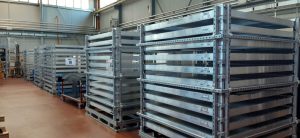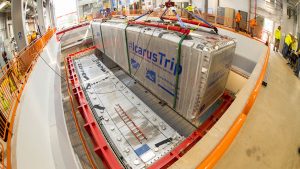
At LNF the construction of the Cosmic Ray Tagger (CRT) for ICARUS-T600 has just ended. The latter is one of the detectors of the Short Baseline Neutrino (SBN) experiment at Fermilab, aiming at discovering the so-called sterile neutrinos at the eV Scale or definitely excluding them.
The experiment will use a beam of muon neutrinos produced by the Booster accelerator and detected via time projection chambers (TPCs) placed in three points along the beam line: SBND (the “near” detector) at 100 m from the target where the neutrinos are generated; MicroBoone at 460 m, and ICARUS-T600 (the “far” detector) at 600 m. A difference in the neutrino event distributions between the near detector and the far one, due to the appearance of electron neutrinos and the disappearance of muon neutrinos, will be attributed to the existence of the so-called sterile neutrino. Unlike active neutrinos, νe, νμ , ντ, this particle does not participate to the weak electron interaction, but it contributes to the phenomenon of neutrino oscillation.
Since the detectors are on the surface, shielded from cosmic radiation only by a few meters of concrete, a system able to identify atmospheric muons passing through the TCPs is needed. The Top Cosmic Ray Tagger (CRT), built at LNF, does precisely this: positioned as a roof over ICARUS-T600, it will make it possible to identify and eliminate the signals induced by the passage of muons. Having completed its physics program at LNGS, in 2017 ICARUS was moved to Fermilab, after a stop at CERN, where the entire TCP was revised and upgraded. At the moment it is undergoing the liquid argon filling phase.
The detector consists of three parts: Top, Bottom and Side CRT to ensure a 4π coverage. Each module of the Top CRT measures the muon position and transit time. The light signal is read by SiPMs glued to the fibers. The gluing phase, one of the most delicate stages, was carried out at the “ex-LHCb” clean chamber; the construction of aluminium containers, as well as the module cabling and assembly were performed in the “capannone Gran Sasso” halls. All 125 modules underwent function tests, efficiency and time resolution measures. The results show all the experiment requirements are satisfied.

The Top CRT realisation involved the collaboration of technicians and researchers of LNF, LNS and the Sections of Bologna, Genova, Lecce, Padova, Milano, Milano Bicocca, as well as CERN, with the support of the Laboratory Direction, Research Division, Technical Division and Administration. Now the modules are ready to sail to America in search of new physics beyond the Standard Model!
Translation by Camilla Paola Maglione, Communications Office INFN-LNF
 INFN-LNF Laboratori Nazionali di Frascati
INFN-LNF Laboratori Nazionali di Frascati